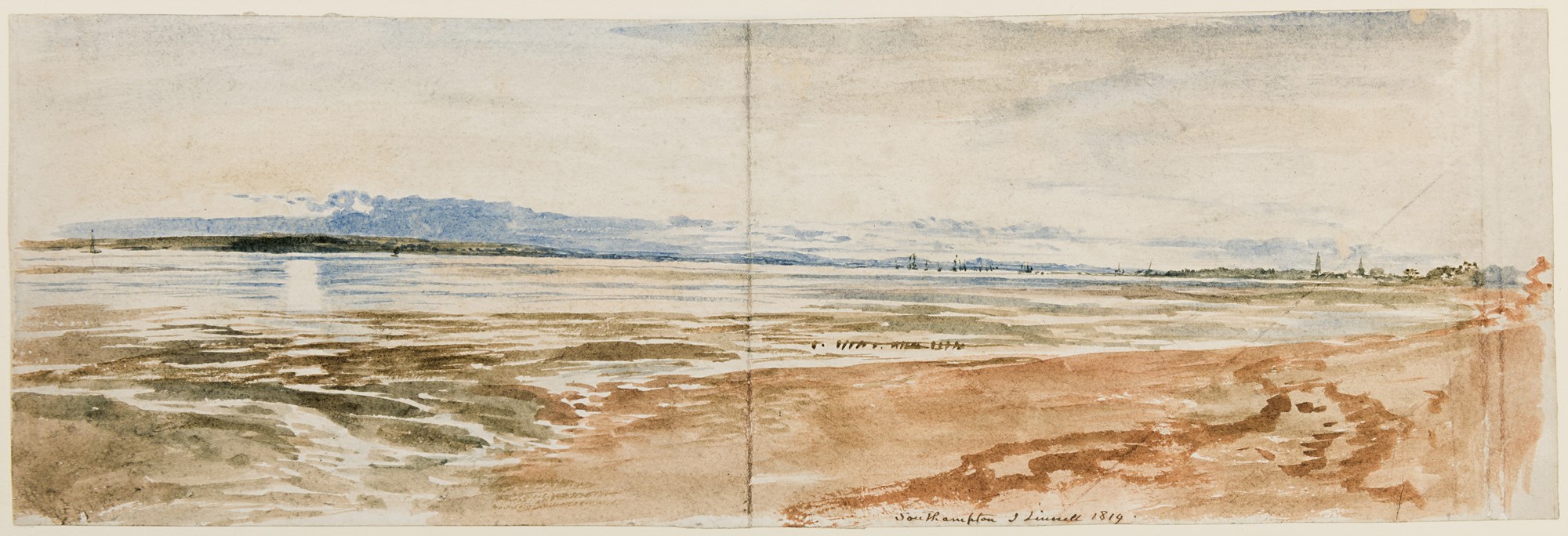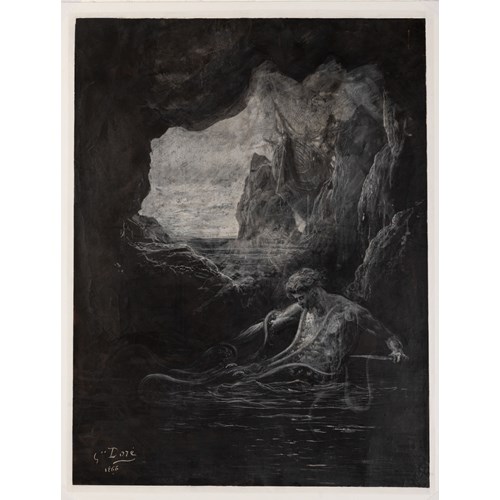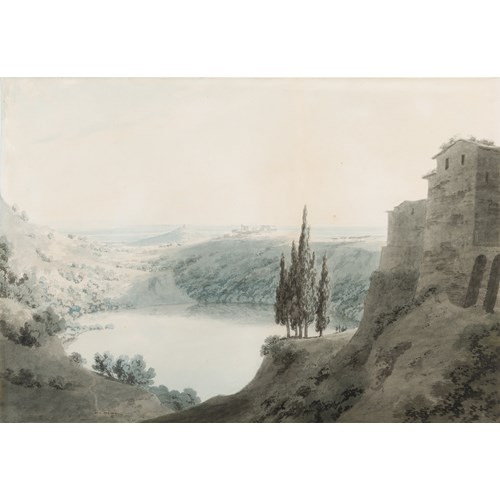Marketplace
Southampton from the River near Netley Abbey, Hampshire
John Linnell visited the port city of Southampton in September and October of 1819. He stayed there as the guest of the painter and engraver David Charles Read, who introduced him to his patron Chambers Hall (1786-1855), of Elmfield Lodge in Southampton. Linnell produced several studies of the landscape around Southampton Water and the Itchen and Test rivers, which he later developed into oil paintings. Drawn on the double-page spread of one of the artist’s early sketchbooks, this sunset view was, some years later, used as a reference study for a small oil painting commissioned from Linnell by the collector Chambers Hall in 1825. The vibrant hues of sunset in the painting delighted Hall and resulted in the commission of a second canvas, The Ferry of Itchen, also painted in 1825. As Hall wrote to Linnell about the painting of Southampton from the River near Netley Abbey, ‘You have indeed realised ideas which I had long cherished of a most magnificent effect of nature, the interest in which is heightened to me from the circumstance of locality…My real ambition is now the Itchen Ferry (morning) as a companion to the sunset.’
As the Linnell scholar Katherine Crouan has noted of the artist’s early works, ‘The skill and power which Linnell brought to his landscape studies from 1811 resulted in a plein air freshness, the most convincing local colour, a remarkable handling of sunlight and shade, and an ability to convey the expanse of landscape through the sum of its minute particulars…Long after many of his contemporaries had retreated to their studios after a brief bout of plein airism early in the century, Linnell continued to paint in oil out of doors, at Cullercoats in 1817, Netley Abbey in 1819, Hampstead in 1821 and 1827 and Bayswater in 1834…With rare exceptions, Linnell never parted with his studies in oil or watercolour, and he didn’t sell them. They were the raw material for his painting, essential for their documentary value but not in themselves art…It was not that Linnell demeaned his studies from nature; he believed that his sketches were the means to an end…However, although Linnell thought of his most intensely naturalistic work as merely factual information about nature, to be re-organised into a personal statement, the sketches he made between 1811 and 1819 take naturalism to the level of a visionary intensity…the sketches Linnell made from 1811 to 1820 provided [him] with material for a lifetime’s work.’
Both this watercolour and the related painting were in the collection of the English painter, writer and curator Lawrence Gowing RA CBE (1918-1991).
As the Linnell scholar Katherine Crouan has noted of the artist’s early works, ‘The skill and power which Linnell brought to his landscape studies from 1811 resulted in a plein air freshness, the most convincing local colour, a remarkable handling of sunlight and shade, and an ability to convey the expanse of landscape through the sum of its minute particulars…Long after many of his contemporaries had retreated to their studios after a brief bout of plein airism early in the century, Linnell continued to paint in oil out of doors, at Cullercoats in 1817, Netley Abbey in 1819, Hampstead in 1821 and 1827 and Bayswater in 1834…With rare exceptions, Linnell never parted with his studies in oil or watercolour, and he didn’t sell them. They were the raw material for his painting, essential for their documentary value but not in themselves art…It was not that Linnell demeaned his studies from nature; he believed that his sketches were the means to an end…However, although Linnell thought of his most intensely naturalistic work as merely factual information about nature, to be re-organised into a personal statement, the sketches he made between 1811 and 1819 take naturalism to the level of a visionary intensity…the sketches Linnell made from 1811 to 1820 provided [him] with material for a lifetime’s work.’
Both this watercolour and the related painting were in the collection of the English painter, writer and curator Lawrence Gowing RA CBE (1918-1991).
Provenance: Sir Lawrence Burnett Gowing, London, by 1968
Thence by descent.
Literature: Frederick Cummings and Allen Staley, Romantic Art in Britain: Paintings and Drawings 1760-1860, exhibition catalogue, Detroit and Philadelphia, 1968, p.238, under no.157; Paris, Petit Palais, La peinture romantique anglaise et les préraphaélites, exhibition catalogue, 1972, p.165, under no.164.
Plus d'œuvres d'art de la Galerie









